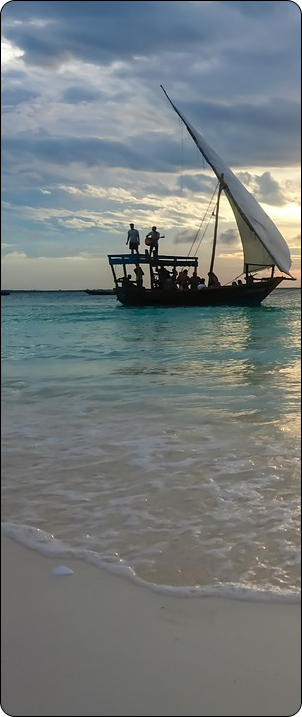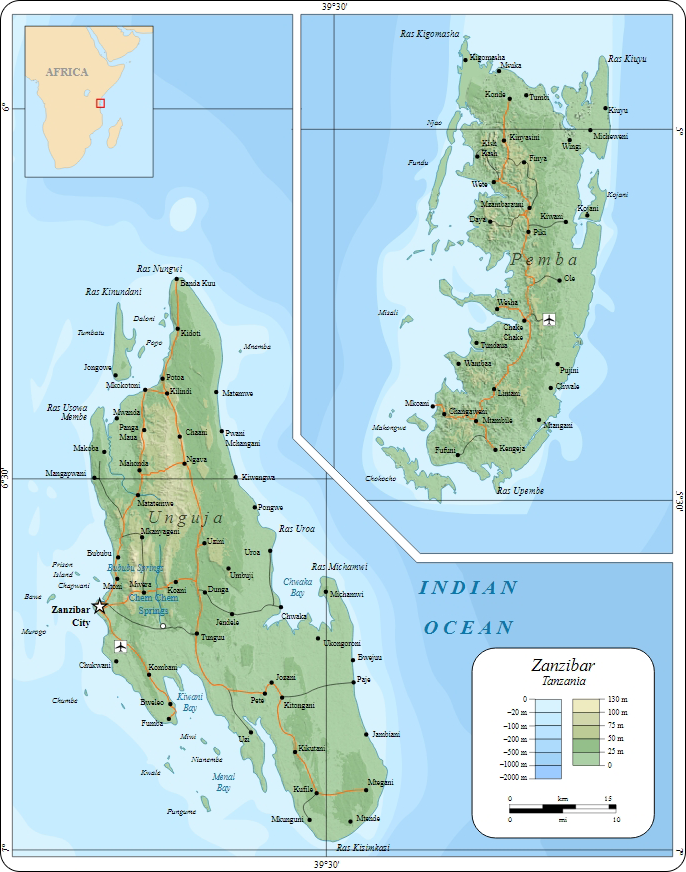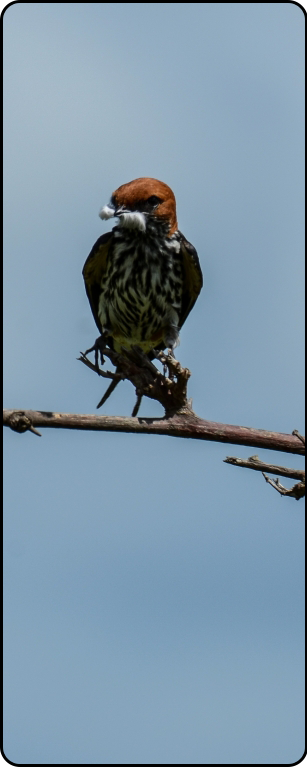Zanzibar...
Zanzibar is a Tanzanian archipelago located off the coast of East Africa. On the main island of Unguja, colloquially known as "Zanzibar", lies Stone Town, a historic trading center with Swahili and Islamic influences. Its winding alleys include minarets, carved doors and 19th century monuments like the House of Wonders, one of the Sultan's former palaces. To the north, the villages of Nungwi and Kendwa offer wide beaches bordered by hotels.
1 STONE TOWN :
Explore Stone Town(the heart of Zanzibar), get to know it’s culture, heritage sites, architecture, cuisine and history, on this walking guided tour .Stone Town was declared a UNESCO World Heritage site in 2000. You'll visit the Old Fort, Macury House, Old slave market, Tip Tip House, Fish and Spice Market, Forodhani Gardens, House of Wonders, Old Dispensary, Ijumaa Mosque, Mbweni Ruins and the Anglican Cathedral.
Old Fort :
With its pale-orange ramparts overlooking Forodhani Gardens and the ocean beyond, the fort was built by Omani Arabs when they seized the island from the Portuguese in 1698, and over the centuries it's had various uses, from prison to tennis club.
Today the scale of the fortifications is still impressive, although there has been some modernisation inside, notably a line of souvenir shops and a pleasant cafe that turns into a bar in the evening hours.
Mercury House :
Freddie Mercury, the former lead singer of Queen, was born in Zanzibar in 1946 where his name was Farrokh Bulsara.
His father worked for the British colonial service and the family lived in various locations in Stone Town, including this house which, for romantics, appears disappointingly modern. It's not open to the public but notices outside tell the story.
Old Slave Market :
Downhill from the boma is the old slave market building, which now houses several craft shops. Unfortunately, it was much less accurately restored than the boma and lost much of its architectural interest when its open arches were filled in. The original design is now preserved only on one of Tanzania’s postage stamps.
Fish & Spice Market :
Market is a have of activity, with everything – from spices, fresh fish, slabs of meat and huge baskets full of live chickens to sandals, plastic buckets and mobile phones – all set out in a series of covered halls and overflowing into the surrounding streets. If you're buying food, come in the morning when stuff is fresh, although it's much busier then. For a slightly less crowded and chaotic experience come in the afternoon.
There are also several stalls catering for tourists selling packs of spice and other souvenirs. In the surrounding streets are shops and stalls selling clothes, shoes, DVDs, electrics and household goods. Especially worth a visit is the area known as Kanga St, where shops sell colourful local prints and fabrics of all kinds.
Forodhani Garden :
Zanzibar's main best ways to stop by this waterfront public space. It's a social hub for tourists and locals alike; there's a large restaurant jutting into the sea, two small cafes with outside seating, benches under shady trees, a children's play park, and food stalls in the evening.
The gardens were originally laid out in 1936 to commemorate the Silver Jubilee of Sultan Khalifa (r 1911–60); you can still see the domed podium where a brass band would play, while the marooned ceremonial arch at the water's edge was built to welcome Britain's Princess Margaret on a state visit in 1956


House of Wonders :
An icon of Stone Town, the House of Wonders rises in impressive tiers of slender steel pillars and balconies overlooking the waterfront. Its enormous carved doors are said to be the largest in East Africa, fronted by two bronze cannon with Portuguese inscriptions dating them to the 16th century. Inside, the National Museum of History & Culture has exhibits on Swahili civilisation and the peoples of the Indian Ocean.
Built for ceremonial purposes by Sultan Barghash in 1883, in its heyday the House of Wonders boasted marble floors, panelled walls and never-before-seen electricity and running water – hence its name. But in 2012, after years of neglect, a large section of balcony collapsed, closing the building's interior to the public.
Restoration has since stalled, and at the time of research there was no date for reopening, but you can still admire the House of Wonders from the outside. Even though the white paint continues to fade to rusty brown, it's still one of the grandest structures on Zanzibar.
Old Dispensary :
With its peppermint-green latticework balconies and sculpted clock tower, this 19th-century charitable dispensary is one of the most attractive landmarks on the waterfront. It was built by Tharia Topan, a prominent Ismaili Indian merchant who also acted as financial adviser to the sultan and as banker to Tippu Tip, Zanzibar’s most notorious slave trader. You’re free to wander through the interior, which now accommodates offices and restaurant.
.
Ijumaa Mosque :
This lovely Arabesque-style mosque is one of the largest in Stone Town. As an Ijumma (means Friday) mosque, the faithful come to pray here, rather than at their local mosque, on Fridays, so it gets especially busy on this day.
Mbweni Ruins :
The upmarket suburb of Mbweni, 5km south of Zanzibar Town, was a Universities Mission to Central Africa (UMCA) base and settlement for former slaves in the 19th century. Built by missionaries for girls freed from slave ships, is now set amid the lush gardens of Mbweni Ruins Hotel. It's an evocative spot, but a long trek from Stone Town, so best combined with a visit to the hotel's restaurant or private beach.
Near Mbweni Ruins is St John's Anglican Church, another thought-provoking reminder of the colonial missionary era. The caretaker-guide is a direct descendant of a freed slave who became the UMCA's first African deacon (junior priest).
Anglican Cathedral Church :
The tall spire and grey-yellow walls of the Anglican cathedral dominate the surrounding streets in this part of Stone Town, while the dark-wood pews and stained-glass windows will remind British visitors of churches back home. This was the first Anglican cathedral in East Africa, constructed in the 1870s by the Universities Mission to Central Africa (UMCA) on the site of the former slave market after slavery was officially abolished. Inside the cathedral, the altar reputedly marks the spot of the whipping tree where slaves were lashed with a stinging branch. It’s a moving sight, remembered by a white marble circle surrounded by red to symbolise the blood of the slaves.
The driving force behind the construction of the cathedral was Bishop Edward Steere (1828–82), but the inspiration was David Livingstone, whose call to compassion the missionaries answered in 1864 when they settled on the island. One of the stained-glass windows is dedicated to his memory, while the cathedral's crucifix is made from the tree that grew where his heart was buried in the village of Chitambo in Zambia.
In the grounds outside the cathedral is the moving Slave Memorial, depicting five slaves standing in a pit below ground level. The poignant figures emerge from the rough-hewn rock and thus appear hopelessly trapped, shoulders slumped in despair. Around their necks they wear metal collars from which a chain binds them. Although nothing remains of the slave market today, the memorial is a sobering reminder of the not-so-distant past.
At the entrance to the cathedral compound is the East Africa Slave Trade Exhibit, a series of displays and informative panels. Also here are the former slave chambers where slaves were imprisoned before sale.
Services are held at the cathedral on Sunday mornings in English and Swahili. Times are posted on a notice in the porch.
2 PRISON ISLAND :
Also Known as Changuu Island was the location where slaves were detained and held until they were transported to places in the Middle East or Europe, after sometime the island was transformed into a quarantine center where people deadly with diseases were left, so they wouldn’t spread their illnesses with the healthy, but today, the island is a nature reserve, and a beautiful place to spend the day ,you will get the opportunity to visit the tortoise sanctuary, which contains a large colony of giant tortoise imported from the Seychelles in the late 19th century. The average weight of these creatures is 200 kg, and many of them are said to be over 150 years old.
There will be a chance to touch the tortoise and take photos. One you can also swim, snorkel, and sunbath or just relax and enjoy the peacefulness that this beautiful island has to offer.
3 JOSANI FOREST :
In the South of Zanzibar Island, Jozani Forest is a wonder and delight, with tales of Zanzibar leopards, medicine cures and stunning scenery. The forest is home to a number of endemic species, including the Zanzibar Red Colobus Monkey.
The Mangrove boardwalk takes you above the swamp, where, depending on the tide, you can see tropical fish flitting between the mangrove roots and crabs scuttling across the mud
At: Jozani Chwaka Bay National Park,We will take you on a nature trail, lined with eucalyptus and mangrove trees and explain the medicinal properties of various plants and tell you about the animals, birds and reptiles that call this tropical rainforest their home.
Troops of Zanzibar Red Colobus monkeys can be found scrambling from branch to branch in search of food. The monkeys have become acclimatised to people and allow you to get close enough to capture them in photographs as they eat, play and jump from the treetops. The mangrove boardwalk takes you above the swamp, where depending on the tide, you can see tropical fish flitting between the mangrove roots and crabs scuttling across the mud. Mangroves play an important role in environmental conservation and is a valuable resource for villagers and community life. Your guide will explain the different species found in the swamp and their uses.Duration: 8 hours
4 DOLPHINE TOURS :
It's fun , such a good experience a thrill of happiness , relaxing in beach in Zanzibar see how to swim with dolphins , I have experience in what am doing also to enjoy your time being and stress relief also learn how to cook and fish sea foods
.The moment you slip into the water, you slip into another world. It’s just you, the warm salty sea, and a pod of dolphins. You can’t see them, but the whistles and clicks let you know that they are there.
It isn’t long before a flash of grey signals that you have company. Suddenly you are surrounded by ten perky bottlenose dolphins who are carving graceful circles through the water, all viewing for your attention.
It is a surreal experience where you are watching them and they are watching you, and for a brief moment, humans and nature are caught in a dance of perfect synergy that reminds us about the connections we share and the harmony that can exist between us, if only we let it.
5 NUNGWI TOURS :
6 SUNSET CRUISE :
Step onto the deck, relax and sail away on a magical sunset cruise to end your day. The sunset cruise leaves in the late afternoon from in front of the Zanzibar Serena Inn and cruises along the Zanzibar (Unguja) coast, slicing through the clear turquoise water.
The hustle and bustle of busy people in Stone Town grow faint in the distance until they seem only a memory.
The sun sets, changing the sky from shades of pinks and blues to magnificent golden colours as you sail back towards the glimmering lights of Stone Town in the distance with the wind gently blowing you back to shore.
End of tour,

Zanzibar & Safari
Choose your trip...

 English
English  Français
Français 





